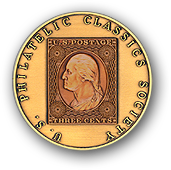Please click a value for in-depth detail.

STATISTICS
Issued: 22nd February 1890, earliest recorded example 27th February 1890

Plate Size: Sheets of 400 subjects (4 panes of 100).

Printer: The American Bank Note Company.
Watermark: None.
Quantity Issued: Two Billion.
Color: Dull Blue.
Common use: The 1¢ Franklin was used for third-class mail and drop letters.
THE PRINTING
Without knowing it, the 1890 series was to be the American Bank Note Company’s (ABN Co.) last printing of postage stamps. Until the flag overun series of the forties all stamps after this series were to be printed by the Bureau of Printing and Engraving.

On the left is shown the detail of a stamp from the 1890 series, note the absence of a triangle in the top left hand corner of the design. All the Bureau issues had a triangle cut into the design as shown on the right.

You will also notice the tremendous difference in quality between the two stamps. By 1890 the ABN Co. had perfected the art of printing postage stamps and it shows by the even ink sharp design and clean perforations. Contrast this with the spotty faded ink and uneven perforations on the Bureau’s stamp on the right.

THE INSPIRATION FOR THE DESIGN
The design was taken from the portrait bust of Benjamin Franklin by Jean Antoine Houdon. Now at the Philadelphia Museum of Art.

Previous versions of Franklins portrait on the 1¢ stamp had Franklin facing to the right. This, along with the pale blue color were the principle reasons that this design was disliked by the general public. The NY Times said that Franklin facing to the left ‘entirely altered his expression and making him resemble a putty-faced personification of senility’.
VARIETIES

Considered a proof by many, the imperforate is classified by Scott as a variety. It can easily be mistaken for the Scott 219P4, the plate proof, see below.

Mentioned by Brookman but rarely seen is the so-called candle flame variety. To the right hand side of either one of the two numeral ones on the stamp extends a white area, said to resemble the flame of a candle. An example is shown above.
The white area is created by a raised portion of the plate, caused by poor workmanship on the plate. When the ink is wiped from the plate this area was also wiped of ink due to it being raised, thus causing the absence of ink above the foot of the number one. The shape and size of the flame can vary, depending how much ink was wiped off at the time of printing, thus this is a printing flaw and not a plate flaw.
ESSAYS AND PROOFS

American Bank Note Company essays are scarce, the small bureaus being no exception. Shown above is a Die essay on ivory paper showing an engraved frame with blacked out labels.

219 P4, the plate proof shown above, is the only example of a proof to be seen at auction in the last thirty years. It was produced on thin white card in 1940.

- Brookman, Lester G., U.S. Postage Stamps of the 19th Century, Lindquist 1966
 .com
.comThe Swedish Tiger’s US Stamp Site An illustrated Guide
Jean-Antoine Houdon and the story behind the Benjamin Franklin Bust.
Please click a value for in-depth detail.

